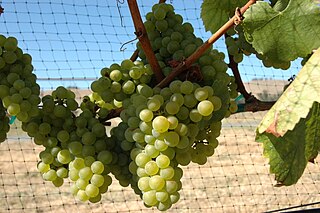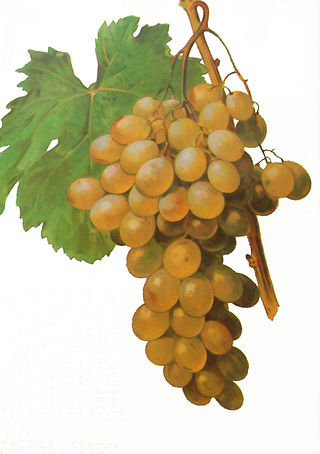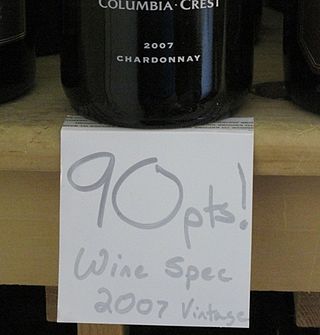
Wine is an alcoholic drink made from fermented fruit. Yeast consumes the sugar in the fruit and converts it to ethanol and carbon dioxide, releasing heat in the process. Wine is most often made from grapes, and the term "wine" generally refers to grape wine when used without any qualification. Even so, wine can be made from a variety of fruit crops, including plum, cherry, pomegranate, blueberry, currant, and elderberry.

Chardonnay is a green-skinned grape variety used in the production of white wine. The variety originated in the Burgundy wine region of eastern France, but is now grown wherever wine is produced, from England to New Zealand. For new and developing wine regions, growing Chardonnay is seen as a 'rite of passage' and an easy entry into the international wine market.

Riesling is a white grape variety that originated in the Rhine region. Riesling is an aromatic grape variety displaying flowery, almost perfumed, aromas as well as high acidity. It is used to make dry, semi-sweet, sweet, and sparkling white wines. Riesling wines are usually varietally pure and are seldom oaked. As of 2004, Riesling was estimated to be the world's 20th most grown variety at 48,700 hectares, but in terms of importance for quality wines, it is usually included in the "top three" white wine varieties together with Chardonnay and Sauvignon blanc. Riesling is a variety that is highly "terroir-expressive", meaning that the character of Riesling wines is greatly influenced by the wine's place of origin.

Icewine is a type of dessert wine produced from grapes that have been frozen while still on the vine. The sugars and other dissolved solids do not freeze, but the water does, allowing for a more concentrated grape juice to develop. The grapes' must is then pressed from the frozen grapes, resulting in a smaller amount of more concentrated, very sweet juice. With icewines, the freezing happens before the fermentation, not afterwards. Unlike the grapes from which other dessert wines are made, such as Sauternes, Tokaji, or Trockenbeerenauslese, icewine grapes should not be affected by Botrytis cinerea or noble rot, at least not to any great degree. Only healthy grapes keep in good shape until the opportunity arises for an icewine harvest, which in extreme cases can occur after the New Year, on a northern hemisphere calendar. This gives icewine its characteristic refreshing sweetness balanced by high acidity. When the grapes are free of Botrytis, they are said to come in "clean". This results in a very complex and sweet wine. Much icewine is made from the grapes Riesling, Vidal, Cabernet Franc and Cabernet Sauvignon, but there is also icewine made from Shiraz, Merlot, Sangiovese and others.

Grüner VeltlinerGerman:[ˈɡʁyːnɐfɛltˈliːnɐ] ) is a white wine grape variety grown primarily in Austria, Hungary, Slovakia, and the Czech Republic. The leaves of the grape vine are five-lobed with bunches that are long but compact, and deep green grapes that ripen in mid-late October in the Northern Hemisphere.

Burgundy wine is made in the Burgundy region of eastern France, in the valleys and slopes west of the Saône, a tributary of the Rhône. The most famous wines produced here, and those commonly referred to as "Burgundies", are dry red wines made from pinot noir grapes and white wines made from chardonnay grapes.
DeLille Cellars is a winery in Woodinville, Washington, USA. Located in the Hollywood District of Woodinville at the former Redhook Brewery, DeLille's hospitality venues include The Tasting Room and The Restaurant at DeLille Cellars. DeLille Cellars specializes in wines using the Bordeaux grape varieties: Cabernet Sauvignon, Merlot, Cabernet Franc, and Petit Verdot. In 2000, DeLille won The New York TimesWine Today.com "Winery of the Year" award. It is one of Washington state's premier cult wines.

Jancis Mary RobinsonOBE, ComMA, MW is a British wine critic, journalist and wine writer. She currently writes a weekly column for the Financial Times, and writes for her website JancisRobinson.com, updated daily. She provided advice for the wine cellar of Queen Elizabeth II.

Veuve Clicquot Ponsardin is a Champagne house founded in 1772 and based in Reims. It is one of the largest Champagne houses. Madame Clicquot is credited with major breakthroughs, creating the first known vintage champagne in 1810, and inventing the riddling table process to clarify champagne in 1816. In 1818, she invented the first known blended rosé champagne by blending still red and white wines, a process still used by the majority of champagne producers.
Krug Champagne is a Champagne house founded by Joseph Krug in 1843. It is based principally in Reims, the main city in France's Champagne region and is one of the famous Champagne houses that formed part of the Grandes marques. Today the house is majority owned by the multinational conglomerate LVMH Moët Hennessy – Louis Vuitton S.E. whose portfolio includes other well known wine brands such as Moët & Chandon, Veuve Clicquot, Château d'Yquem and Ruinart. Despite LVMH's majority ownership, the Krug family is still actively involved in all the key decisions of the house but does not manage the day-to-day operations.

Armand de Brignac, known colloquially as Ace of Spades, is a French Champagne owned by Shawn "Jay-Z" Carter and LVMH. The brand is produced by Champagne Cattier and sold in opaque metallic bottles. The brand's first bottling, Armand de Brignac Brut Gold, is identifiable by its gold bottle with French pewter Ace of Spades labels.

Muscat of Alexandria is a white wine grape that is a member of the Muscat family of Vitis vinifera. It is considered an "ancient vine", and wine experts believe it is one of the oldest genetically unmodified vines still in existence. The grape originated in North Africa, and the name is probably derived from its association with Ancient Egyptians who used the grape for wine making. It is also a table grape used for eating and raisins.

Bonny Doon Vineyard is a winery in the Santa Cruz locale, that focuses on terroir wines. Founded by Randall Grahm in 1983, it is perhaps best known for its quirky labels, eccentric mix of grapes, and humorously named wines—like its flagship wine, "Le Cigare Volant". It was amongst the first Californian wineries to embrace Rhone varietals, and entered the national spotlight in 1989, after Grahm appeared on the cover of Wine Spectator as "The Rhone Ranger."

California wine production has a rich viticulture history since 1680 when Spanish Jesuit missionaries planted Vitis vinifera vines native to the Mediterranean region in their established missions to produce wine for religious services. In the 1770s, Spanish missionaries continued the practice under the direction of the Father Junípero Serra who planted California's first vineyard at Mission San Juan Capistrano.
Matt Kramer is an American wine critic since 1976. He is a columnist for The Oregonian, was a columnist for The New York Sun before its demise in 2008, and previously for Los Angeles Times, and since 1985 is a regular contributor to Wine Spectator. He has been described as "perhaps the most un-American of all America's wine writers", by Mike Steinberger as "one of the more insightful and entertaining wine writers around", and by Hugh Johnson as "an intellectual guerrilla among wine writers".
In computing, a natural user interface (NUI) or natural interface is a user interface that is effectively invisible, and remains invisible as the user continuously learns increasingly complex interactions. The word "natural" is used because most computer interfaces use artificial control devices whose operation has to be learned. Examples include voice assistants, such as Alexa and Siri, touch and multitouch interactions on today's mobile phones and tablets, but also touch interfaces invisibly integrated into the textiles of furniture.

A wine rating is a score assigned by one or more wine critics to a wine tasted as a summary of that critic's evaluation of that wine. A wine rating is therefore a subjective quality score, typically of a numerical nature, given to a specific bottle of wine. In most cases, wine ratings are set by a single wine critic, but in some cases a rating is derived by input from several critics tasting the same wine at the same time. A number of different scales for wine ratings are in use. Also, the practices used to arrive at the rating can vary. Over the last couple of decades, the 50–100 scale introduced by Robert M. Parker, Jr. has become commonly used. This or numerically similar scales are used by publications such as Wine Enthusiast, Wine Spectator, and Wine Advocate. Other publications or critics, such as Jancis Robinson and Michael Broadbent, may use a 0–20 scale, or a 0–5 scale either with or without half-star steps.
Cava is a sparkling wine of denominación de origen (DO) status from Spain. It may be white (blanco) or rosé (rosado). The Macabeo, Parellada and Xarel·lo are the most popular and traditional grape varieties for producing cava. Chardonnay and Malvasia are also permitted. Authorized red grapes are Garnacha tinta, Monastrell, Trepat, and Pinot Noir. Only wines produced in the traditional method may be labelled "cava"; those produced by other processes may only be called "sparkling wines". About 95% of all cava is produced in the Penedès area in Catalonia, Spain, with the village of Sant Sadurní d'Anoia being home to many of the largest Catalan production houses. The two major producers are Codorníu and Freixenet. Cava is also produced in other villages in the provinces of Girona, Lleida, Tarragona, and Barcelona in Catalonia, Zaragoza in Aragon, Badajoz in Extremadura, La Rioja, Araba/Álava in the Basque Country, Navarra and València in the Valencian Community.

The Adrianna vineyard, planted at almost 5,000’ elevation in the Andes foothills, lies on the westernmost border of Tupungato Alto, Mendoza, Argentina, in a small district called Gualtallary. It belongs to the Bodega Catena Zapata. Being the highest vineyard in Mendoza, it benefits from the cooling effect of the Andes Mountains and intense sunlight resulting from extreme high altitude. The increased sunlight intensity due to altitude translates into thicker grape skins, because the grapevine attempts to protect its seeds from the sun. Grape skins are rich in tannins and polyphenols, the flavour-giving compounds in wine, explaining why the Adrianna Vineyard's high-altitude wines are so concentrated and capable of ageing. Also, because of the cool mountain climate, the wines from Adrianna have a certain type of minerality in the aromatics and palate that is not found in wines from other parts of Mendoza. The soils of Catena Zapata´s Adrianna Vineyard are composed of limestone and large pebbles that make them particularly well drained; the yields are naturally low and berries are small and concentrated Adrianna is possibly the world’s most studied vineyard. The Adrianna Vineyard is well known for its single parcel Chardonnay wines White Bones and White Stones. and its Malbec, which have been highly reviewed by world wine publications